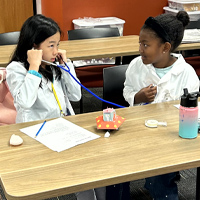
3 October 2024
A Dose of Pharmacreations
Joyce Pritchett
Medical and Pharmacy Students Join Forces to Teach Young Students
How would you treat pain in an alien, monster or superhero patient? For the young students enrolled in A Dose Of Pharmacreations, a course offered by the Sally Ride Science Academy within University of California San Diego Division of Extended Studies, the answer was multi-fold. However, the key to solving the pain problem was collaboration.
Offered to elementary and middle school students, the week-long summer course provided a unique opportunity for young learners to explore the vital role of pharmacists and how pharmacists and physicians collaborate to care for patients. Created and initially taught by Kristine Schneid, Sally Ride Science course developer and instructor, this past summer the course was adapted a bit to be taught instead by students from UC San Diego School of Medicine and Skaggs School of Pharmacy and Pharmaceutical Sciences.

“Growing up interested in health care, I feel like my career options were sort of reduced to either doctor or nurse,” said Rachel Bryant, second-year medical student, who taught both the elementary and middle school courses. “Even starting college, if you were interested in medicine the only “track” that was really advertised was the pre-med track. In reality, there are so many different positions and roles within the health care system that involve various components of patient interaction and medical care.”
For third-year pharmacy student, Monica Le, helping to teach A Dose of Pharmacreations was exciting because of the young students’ enthusiasm for learning.

“I loved participating in this course because I was able to see the interests spark in each student when they engaged in activities or asked thoughtful questions,” said Le. “Courses like these are important for younger students as it allows them to explore different career paths that are not as commonly discussed and expose them to unique skill sets such as critical thinking when compounding medications.”
In addition to working with the young learners, both Le and Bryant noted that volunteering to teach courses like this one is critical to their own learning.
“Volunteering in these types of collaborative courses as a pharmacy student allowed me to interact with my medical student counterparts outside of a didactic setting and provide additional team-building experience,” said Le.
The concept of interprofessional education (IPE) is not a new concept; most health care students experience various levels of IPE throughout their education careers. Medical, pharmacy, nursing, dental and physician assistant students often work together at various points in their educational journeys. The opportunity for medical and pharmacy students to be both teacher and learner through this course is unique.
“The course was initially designed to increase awareness about the pharmacy profession,” said Steve Schneid, director of educational development and scholarship at the School of Medicine and School of Pharmacy. "After the first year, we had the opportunity to shift the focus of the course a bit towards interprofessional collaboration and leverage our amazing teaching and learning concentration medical students. This type of training is essential for optimizing safe and effective patient care.”
For Bryant, she has always been drawn to the collaborative nature of teaching and mentoring so teaching this course was particularly valuable.
"Even going into teaching this course, there was so much I didn’t know about what it means to be a pharmacist,” said Bryant. “I feel so grateful for the pharmacy students who volunteered to help out and offer their perspective in this class. I walked away better prepared to work in a clinical setting as a part of a team alongside pharmacists and other health care professionals."
For the young students enrolled in the course, the hands-on experiences included identifying allergies, learning to use EpiPens and inhalers and compounding different kinds of medication. Additionally, they learned the differences between physicians and pharmacists and had a question and answer session with Andrew Willeford, Pharm.D., Ph.D., assistant clinical professor at the pharmacy school, about his role as a clinical pharmacist and faculty member. The students even got to participate in their own white coat ceremony, where each student received a white coat to remind them of their potential to pursue a career in health care.
“I was so impressed by the level of engagement from the students at such a young age,” said Bryant. “We covered some pretty nuanced topics, and I was blown away by how much they retained and what they took away from our week together. They continuously challenged me, asking tough questions, and even going home to do their own research on some of the topics we discussed in class.”
A Dose of Pharmacreations will be offered again in July of 2025. Learn more